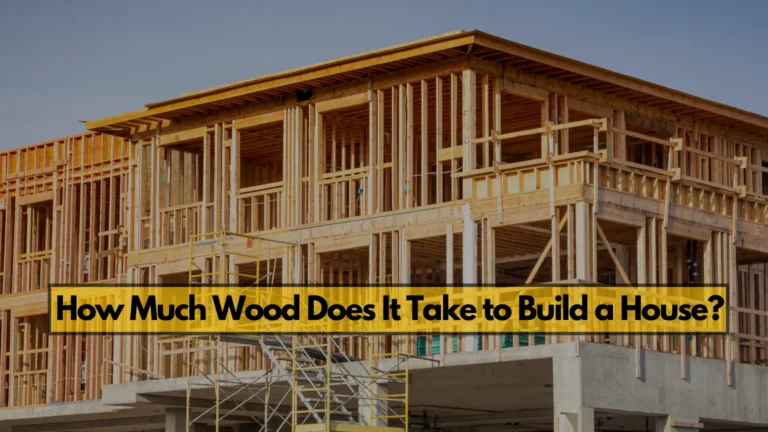How to Build Wooden Carport?
A wooden carport is the perfect combination of functionality and aesthetic appeal. It provides shelter for your vehicles and enhances the charm of your property. Building one doesn’t just protect your car from the elements but also adds a sense of permanence and natural beauty to your home’s exterior. The process may be pretty easy yet very fulfilling if you’re looking for something as simple as a simple structure or something more complex involving solar panels or even a green roof.
The process is divided into the main areas of choosing durable material to create a functional yet aesthetically pleasing wooden carport when evaluating your space and understanding the building codes that must be complied with. With proper planning and attention to detail, you can create a carport that will meet your needs while enhancing your home’s general appearance. Let’s get into the steps of building your wooden carport. This guide will take you through everything you need to know, from planning and material selection to frame and roof construction.
What is a Wooden Carport?
A wooden carport is a roofed structure meant to protect the automobile from natural elements, something a practical solution while being aesthetically pleasing, too, especially for homeowners. Compared to this, though, it may not be all of a complete garage, usually open from one side, with the top almost partially enclosed. This is made from strong wood, which provides an efficient and cost-effective solution to car cover. It is a versatile and cost-effective alternative for the purpose of a wooden carport. It is not only helpful and makes the property more visually appealing.

Why Build a Wooden Carport?
Building a wooden carport offers several benefits. The foremost advantage is the protection of the vehicles from environmental destruction. It protects your car from rain, snow, ice, and direct sunlight, which might add more years to your vehicle’s life. In addition, a well-designed carport can significantly enhance the usability of your property by offering additional space for storage or other activities. Furthermore, by improving the usability of your outdoor spaces and increasing your property’s value, a wooden carport may offer a return on investment in the long term.
Major Advantages
There are several advantages a wooden carport has compared to other car covers.
Low Cost: A wood carport will be a lot cheaper compared to setting up a whole garage. It uses more affordable materials to construct, and its construction process is less involved and does not take many hours to consume.
Aesthetic Appeal: Wood has an aged, earthy feel. This may well be mixed with most designs of homes. You can give your carport a personalized look and style so that it may complement the beauty of your home. This is going to be an attractive view of your house, making it look uniform as well.
Durability: A wooden carport can last for centuries if constructed correctly from pressure-treated lumber. A wooden structure is very resistant and will likely outlive adverse weather conditions so long as it is correctly cared for.
Simple Construction Process: Wooden carports are not complicated and can be built with minimal hassle. This is an excellent project if you possess basic DIY construction skills, allowing you to execute it independently.
How to Build Your Wooden Carport?
A wooden carport is an excellent addition to any property. It not only protects your vehicle from the harsh weather but also gives a rustic feel to your home. Although the project of building a wooden carport may look intimidating, the whole process of construction can be simplified with some proper planning and methodical approaches. It’s one of the most rewarding DIY projects that can be carried out with minimal basic carpentry skills and essential tools. Here are some steps to build a wooden carport.
Planning and Design
Do not run to pick your hammer. Before the process, take some time to plan. With proper planning, you get a successful build and avoid many common mistakes. Location and size selection
The selection of the right location to erect a wooden carport begins with the basics. Ideally, the site chosen should be level, easy to access, and free of all obstructions. Its proximity to the driveway is something to consider when considering how much land slopes. If it’s sloping by about an inch over a foot, take care to level the ground to provide the best possible stability.
Determine Carport Size
It would be approximately 12 by 20 feet long for a one-car carport and, for a two-car, roughly 18 by 24 feet. Take additional space for the size, length, and width of the automobile, plus the door space to swing them open. Additional features that consist of storage increase the carport size.
Building Permit and Regulation
Before you start construction, always be sure to inquire about permits from the local zoning office and check whether your carport will be in compliance with local building codes. The setback of some carports might be restricted due to specific properties of local jurisdictions; others might limit the limited type of material used, among others.
Materials
It’s important to use high-quality materials to ensure the carport’s durability and stability. A precise lumber takeoff is crucial for determining the necessary wood components, along with other essential materials such as the following:
- Pressure-treated lumber (4×4 posts, 2×6 beams, 2×6 rafters)
- Concrete mix for post footings
- Roofing materials (corrugated metal sheets, asphalt shingles, or polycarbonate panels)
- Nails, screws, and brackets
- Power tools (saw, drill, level, measuring tape, hammer, and nail gun)
Tools: You should have a circular saw, a drill, a level, a hammer, measuring tape, and safety equipment, including gloves and goggles.
Site Preparation and Foundation
With your design in place and all equipment prepared, go ahead and mark the positions of the post for your wooden carport. A carport needs an excellent foundation since it is directly related to its structural integrity as well as how stable the overall structure will stand. This will be marked up and et for the posts that act as the ‘backbone’ of the overall structure.
Marking of the Layout
Begin by putting stakes and some string on the ground to mark the corner of your carport. In order to see that the layout would be square, measure it with tape. Mark exactly where each of the posts will be, taking care that every post is distanced equally well and aligned with the enormous structure.
Dig Holes for Setting Posts.
Dig holes for your four main corner posts using a post-hole digger or shovel. The holes should be about 2 feet deep, or according to the frost line in your area. This depth will ensure that it is protected from frequent and drastic changes in temperature so the post does not shift. The diameter of the hole should be large enough for the diameter of the 4×4 post.
Setting the Posts
Place the 4×4 posts into the holes and check that they are perfectly vertical using a carpenter’s level. Then, brace each post with temporary supports to hold them in place. Once positioned, pour concrete into each hole around the post. This concrete will serve as the foundation for your carport and will help secure the posts in place. Let the concrete cure for at least 24-48 hours before proceeding.
Framing
After laying the foundation, it is now my turn to start building the frame. This is the step that will create the entire shape and provide enough support to hold the roof in place. This step includes attaching beams, rafters, and braces to make it a strong frame.
Attaching the Header Beams
The header beams are the top perimeter of the carport. Cut two 2x6s to match the width of your carport. These beams will sit on the tops of the posts. Attach them with brackets or screws. Ensure that the beams are level and well-aligned to make a stable top structure.
Side Beams
Cut two more 2×6 beams to the length of the carport and install them alongside the header beams. These would provide lateral support. Side beams help stabilize and align the structure. Secure them with screws or metal brackets.
Install the Rafters
The rafters will support the roof of the carport. Cut the 2×6 rafters to the desired length, but ensure they are longer than the length of the carport for coverage. Position the rafters 2 feet apart for ultimate support. Use screws or metal brackets to place each rafter on the header beams. Be sure the rafters are placed equidistant and square to the structure.
Bracing for Sturdiness
This diagonal bracing would be fitted between the posts and beams to stiffen the carport, thus minimizing the possibility of sway. This would be able to withstand the general wind and other influences from the environment.
Roofing the Carport
The choice of the right roofing material, in combination with the correct installation, is the way to ensure durability and protect your vehicle from the weather. The roof will be your car’s primary defense against rain, snow, and the scorching sun, so the details actually matter.
Selecting Roofing Material
The type of roofing material you will use will actually depend on your budget, climate, and personal preferences. For wooden carports, some of the following are the popular options:
- Corrugated metal sheets: These are very powerful, resistant to weather, and also pretty easy to install.
- Asphalt shingles: While they are very traditional, asphalt shingles do give a very refined look, and they can be used together with other buildings that have used the same type of materials.
- Polycarbonate panels: If one wants to enlighten the carport, these polycarbonate panels are an ideal choice.
Installation of Roof
Start with the bottom, laying down the roofing material over the carport. Overlap every sheet or panel as you ascend. Overlapping the roofing material will prevent the entrance of water through your carport. If making use of metallic sheets, then it is pretty advisable to attach using metallic roofing screws while at the same time making sure that every one of them pierces the rafters firmly.
Install a Ridge Cap
After installing roof panels at the top, a ridge cap is installed across the roof. The ridge cap covers the seam of two slopes and, therefore, also protects it against water and snow.
Finishing Touches
Once the roof is on, it is time to view finer points that will add functionality and aesthetics to your carport. Side panels and fresh coat paint or stain will help make your carport match your home while withstanding the elements for many years to come.
Installing Side Panels
You can add vertical side panels or wooden lattice between the posts to give it an enclosed appearance, according to your design preference. These panels will protect your vehicle from wind, rain, and debris.
Paint or Stain the Carport
Now, treat some wood incorporated into your carport to ensure it has a long service life. Depending on the situation, this could be staining or painting wooden carport structures using exterior stains or paint for added durability. Always ensure a matching exterior paint of what your home features in the surroundings, especially where the carport features. Lastly, ensure that it fits by measurements.
Final Inspection
Before you declare the project complete, inspect every part of the carport. Check the roof attachment; the posts in the concrete should be firmly set, and loose screws or nails need to be tightened. All adjustments will be made.
Maintenance
After you have constructed your carport, routine maintenance will be needed to ensure it stays in good shape. Over time, the structure is vulnerable to wear and tear caused by weather factors. You’ll be able to avoid costly repairs if you carry out regular checks and maintenance of your carport.
- Inspect the roof every year for damage or wear and replace damaged roofing materials.
- Reapply stain or paint every few years to protect the wood from the elements.
- Inspect for signs of termite or wood rot, which can be evident if the carport is often exposed to water.
Types of Wooden Carports
Here are the types of wooden carports.
Attached Carports
Carports are attached to the house and shared, most of the time, with just one wall for structural support. It’s ideal when you want to maximize the usage of your existing property without having too much space occupied.
Freestanding Carport
The freestanding type of carport is independent of the house and can be placed anywhere on the property. They offer more room on where it may be placed but require more supporting structures to stabilize it.
Open Sided Carports
The most straightforward designs for carports are open-sided carports; they provide primary protection from rain and sunshine without the need for walls. For this design, there is superb ventilation and easy access, but it offers less privacy and shelter.
Walled Carports
Wall or paneled carports offer increased protection and privacy. This has similarities to garages, but they come cheaper and are relatively more straightforward to erect.
Ways to Design a Wooden Carport
Your design for the carport is, of course, most important when it comes to functionality and aesthetic needs, as well as how it fits with the balance of your other property. Whether simple in design or very complex, one must consider the specific requirements for that particular piece of land and available space.

Needs Assessment
Vehicle Specifications: Determine the size and number of vehicles housed in the carport. This determines the dimensions of the carport. You may want a wider or taller structure to accommodate oversized vehicles or to allow extra space for easy maneuvering.
Additional Uses: Determine if the carport should be used for purposes other than providing shelter for your vehicles. For instance, if you want to use the space as a workshop, storage area, or even a shaded outdoor seating space for gatherings, you will need to factor that extra space into the design and possibly add features such as sidewalls, shelving, or lighting.
Innovative Design Features
Green Roof: Green roofs can even be applied to carports. A green roof or living roof is a design in the name of sustainability with a view of placing planting life onto the carport’s roof. Apart from insulating the room, a green roof lowers the possibility of rainwater running off the roof and even provides an eye-catching sight. It is just one method for integrating your edifice into nature.
Solar Panel Integration: Installing solar panels on the roof of your carport can make it more energy efficient. This harnesses the sun’s energy to power outdoor lighting, security systems, or electric vehicle charging stations.
Modular Design: There is enough space to add more bays, which makes it expandable for future needs, thus saving time and effort in the long run. You can add more bays or storage areas according to your changing needs. For example, you may get more cars and want more outdoor hobbies later in life, so you can quickly expand them.
Modern or Rustic Styles: Choose the design that best suits your house. A contemporary house can be made with smooth lines, minimal designs, and metallic or steel accents on the carport structure. A wood-heavy design will suit your house’s rustic or traditional look, giving it natural finishes that blend well with your property’s aesthetic.
Additional Features: Sidewalls and Privacy This is another common feature for some carports that want extra privacy or protection against the elements. The sidewalls or partial panels can be provided and made of wood, metal, or polycarbonate sheets for transparency in blocking wind, rain, or snow. That is particularly true in extreme weather regions.
An Open vs Closed Carport: The last decision depends on whether an open-sided carport is closed. Open-sided carports allow the carport area to be even more ventilated and accessible, creating a fresh breathing space for ideal living, which breathes mainly if one stays in a moderately pleasant climate. A carport would be considered closed when more protection is warranted against wild animals, possible thefts, etc.
Conclusion
A wooden carport is a good investment with practical and aesthetic benefits. Proper selection of the right materials and incorporating innovative features in your design will give you that which adds value to your property and does the job well. If you properly maintain it, your wooden carport will be there for years to provide reliable protection.

Tony Cummins began his career as a carpenter in a sawmill, where he learned the ins and outs of cutting and processing wood. Over the years, he honed his skills and gained vast knowledge about different types of lumber and their uses. After many years of working directly in the industry, he decided to start his company for preparing lumber takeoffs to help contractors.
















